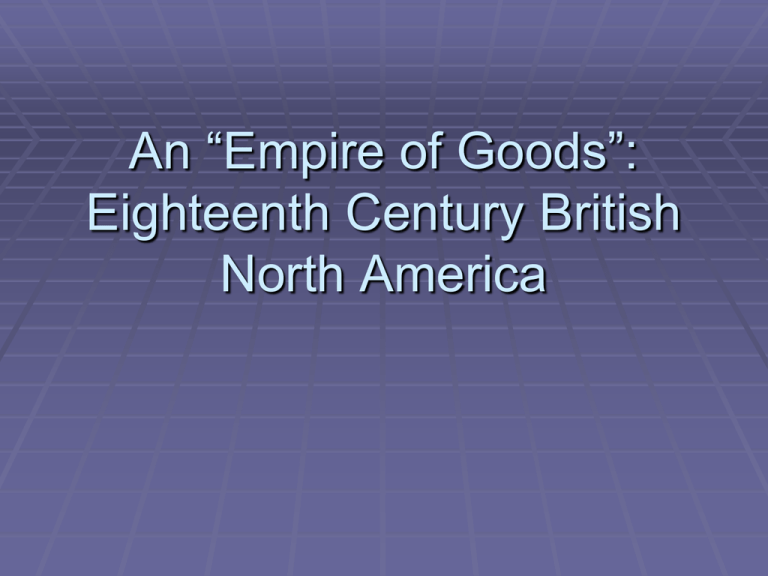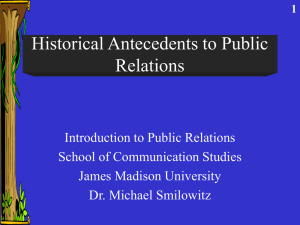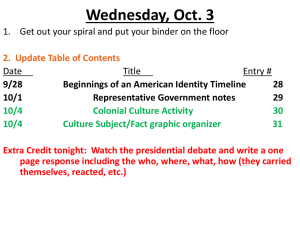An “Empire of Goods”: Eighteenth Century British North America
advertisement

An “Empire of Goods”: Eighteenth Century British North America (71) Between 1607 and 1763, Americans gained control of their political and economic institutions. To what extent and in what ways do you agree or disagree with this statement? (78) Although the thirteen American colonies were founded at different times by people with different motives and with different forms of colonial charters and political organization, by the Revolution the thirteen colonies had become remarkably similar. Assess the validity of this statement. (89) In the two decades before the outbreak of the American Revolutionary War, there was a profound shift in the way many Americans thought and felt about the British government and their colonial governments. Assess the validity of this statement in view of the political and constitutional debates of these decades. (95) For the period before 1750, analyze the ways in which Britain’s policy of salutary neglect influenced the development of American society as illustrated in the following: Legislative assemblies Commerce Religion I. Introduction: Anglicization and Americanization 2 v. diff. social systems in 17th (NE + VA) not caused by slavery, rather slavery result diff. and then reinforced How did these come together as Americans to fight in Rev? To become American had to become more English (Anglicization): had much to do w/18th century city II. Population Growth and Diversity 1700: 250,000 colonists (Tenochtitlan 1520) Pop. explodes after 1700: more rapid than any other western society Doubles every 25 years: 1) low mortality (less disease, abundance food) 2) immigration (Scotch-Irish, Germans) 3) high birth rate (natural increase) A. Change in Colonial Immigration Policy English migration continues but 1) discouraged except lowest orders increasingly need workforce 2) encourage immigration from outside England: offer easy naturalization Scotch-Irish: N. Ireland Protestants Germans: Pennsylvania Dutch (Deutsch) Both come for opportunity Bring religious and ethnic diversity B. Changing Demography 1776: ½ South non-English real cultural and social problems S-I resent Eng in particular and authority in general frontier squatters Germans resisted acculturation (esp. Amish and Mennonites) New immigrants want/need move West for land: Land taken up by first immigrants Maintain culture/religion Effect: growth (pop and territory), diversity, dispersal Conflict w/Indians (Doc B) So, how come together as Americans? III. Commerce and the Colonial City Society overwhelmingly rural (95%), but by AR 20 urban center over 3,000 Big 3: Boston (15,000), NYC (25,000), Philadelphia (40,000) (others along coast, esp. in North) A. “Empire of Goods” Trade (ocean-going commerce) foundation urbanization, colonial wealth, and Anglicization Merchants bought raw materials from interior (esp. food) Caribbean for molasses back to make rum slaves Caribbean Also fur trade and ship building English send woolens, hardware, and esp. luxury goods 1740-1770: 360% rise English exports to colonies (esp. to cities) These goods linked together wide variety of people (rich, poor, rural, urban, European, Indian, African) into shared consumer culture McRoyal with Cheese B. Colonial Cities Gap btwn rural and urban in 18th nothing by modern standards (hogs running wild in NYC) BUT would be shock to backcountry farmers or small townspeople Urban diversity (class, racial, ethnic) Luxury Vice (brothels, thieves) Anonymity (that aided vice) Filth Traffic Fires New institutions: Prisons Alm houses (poor) Greater cultural stimulation: Book shops Libraries Theaters Social clubs IV. Provincialism and the Anglicization of Colonial Culture A. Provincial Culture Colonial culture was provincial: not selfcontained, draw from larger, superior center, following fashions and fads (Danville and SF/Oakland) Esp. at top of society; Doc C Overseas trade made this possible: Boston and Phila. closer contact London than some English cities Ships carried ideas, news (sometimes more valuable than goods) Colonial cities resembled England: architecture, furniture, fashions, taverns B. Phases of Social Development 1. Social simplification: demands of survival disorientation + adaptation to new environment (except NE) 2. Social elaboration: creolized variants adaptation to changes but mixed w/elite demands to resemble England 3. Social replication (Anglicization): elites drive recreation of English society Diff. Regions developed at diff. rates and in diff. ways, but all tending along same trend V. 18th Century Boston Increase Mather (major Puritan minister): Boston the land of the dying: impact of commerce New elite of imperial bureaucrats: elaborate homes + slaves (conspicuous consumption) Wealthy colonial merchants follow suit Slackening of Congregationalism some returning to Anglican Church (to fit in with imperial elite) Growing opulence: Georgian mansions, paintings (esp. John Copley) Theater didn’t do well (Puritanism) but growing number private companies By American Revolution, Boston boasted a private society committed not only to religion but also commerce, theater, art and architecture, and the finer things in life. E.g. Paul Revere, silversmith VI. From Anglicization to Americanization This life not lived by all Only 5% in cities, and only small % of this lived this life BUT process overflowed cities and rich Visitors, newspapers, “empire of goods” (T.H. Breen) More English became, more had in common (across space and class) Boston more like Williamsburg, VA, and vice versa Identification w/all things English (esp. rights; Doc E) ironically led to questioning of things English (esp. opulence) Begin to celebrate American simplicity and see selves as different from (and superior to) English (Doc D)






